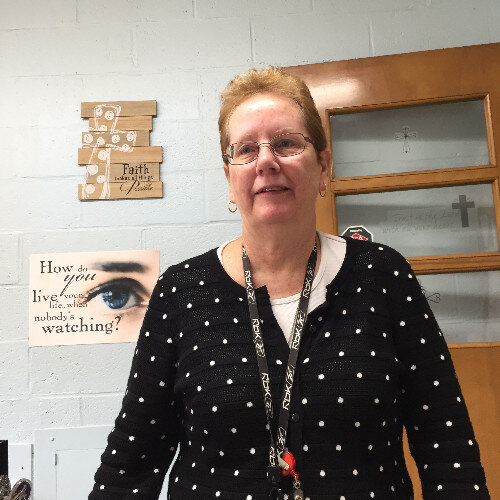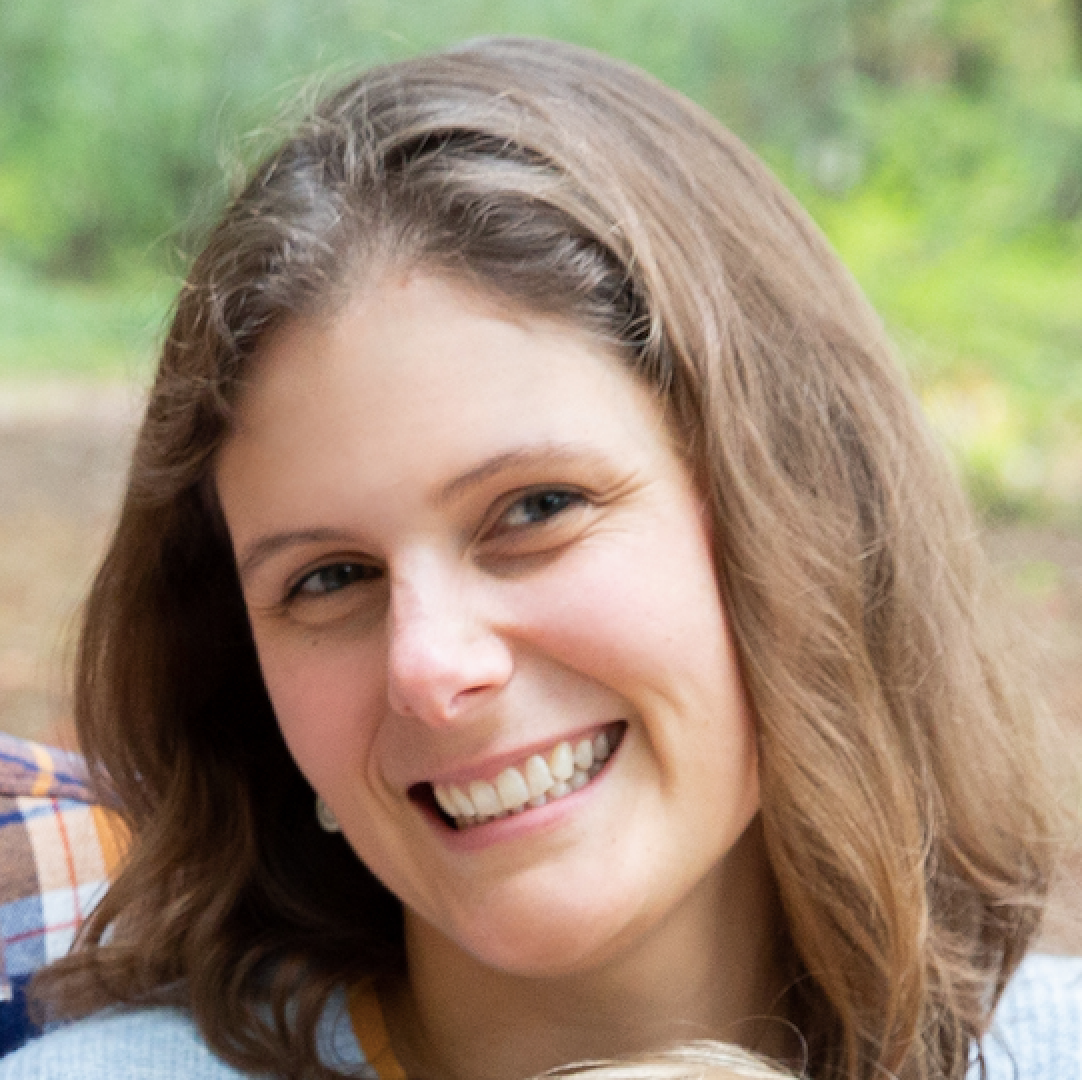Last year, 13-year-old Lili of Sacred Heart STEM School in Boston, MA was a 7th-grade environmental engineer “learn[ing] how what we build affects the ecosystem and how we can save our planet.” She and her classmates Ansen, 13, and Natalie, 14, were working in teams as engineers, project managers, architects, etc, building model bridges that eventually would have been strong enough to support the weight of one of their younger classmates.

From top left, clockwise, 8th graders Lili, Natalie and Ansen of Sacred Heart STEM School in Boston, MA
Project “Pontifex”—which translates to “one who builds bridges” and is a nod to the Catholic Pope—was a school-wide, interdisciplinary project that covered all areas of science, technology, engineering and math, as well as religion and social justice. While the oldest students were the ones designing and building the actual bridges, students in younger grades designed the fictional neighborhoods surrounding the bridges and studied the impact that real-life versions would have on the environment as well as the nearby communities.
Project Pontifex was also building bridges to some of Sacred Heart’s most vulnerable students.

Principal Monica Haldiman

Assistant Principal Kate Cody
Principal Monica Haldiman and Assistant Principal Kate Cody have been deeply focused on doing better by their students who have diverse learning and thinking needs that occur as a result of brain-based differences. With this goal in mind, Haldiman and Cody began to re-frame their school’s instructional model through the lens of Universal Design for Learning (UDL), which is a “framework to improve and optimize teaching and learning for all people based on scientific insights into how humans learn,” (The UDL Guidelines, 2020).
Through this lens, the duo recognized that some of their most vulnerable students were struggling to demonstrate their mastery of concepts via more traditional routes like assessments, essays, etc, and that project-based learning opportunities such as Project Pontifex could afford “everyone a chance to be the best that they [can be].” Their students with learning and thinking differences have flourished with the newfound sense of confidence that came with their academic success.
Utilizing the UDL framework also had an unanticipated, positive impact on other students at Sacred Heart. In particular, by giving all students the opportunity to demonstrate their mastery via a medium that makes the most sense to them, Sacred Heart has witnessed students become the “CEOs of their own education” who are now empowered to advocate for themselves. “If they think they have a better idea to show their knowledge, they’ll go to the teacher and say, ‘I have this idea that I can show you that I understand metaphors and similes and things like that, but I want to put it into this format,’ and we let them have it,” says Cody. Haldiman says, “You can do a video, you can write a song… however you think best the concept is going to get through and be clear to your audience. And these kids come up with amazing things.” This is a direct tie-in to the ultimate goal of UDL, which is to foster expert learners.
In addition to providing their students with an equitable opportunity to demonstrate mastery, Project Pontifex is also a metaphor for the school’s tight-knit community.
The school’s K-8 students, teachers and even Boston community partners like construction firms and local architects banded together throughout the project and were equally crushed when the pandemic put the bridges on hold. Even though Sacred Heart’s 8th-grade class of 2020 has since graduated and moved on to various high schools throughout the city, most plan to be involved when the project resumes during the 21/22 school year.
Students sense and value the uniqueness of their close community as well. 8th-grader Lili came to Sacred Heart just two years ago and says of her previous school, “The community wasn’t as tight as this one,” but now, “I feel like I belong [at Sacred Heart].” Ansen has been at Sacred Heart slightly longer than Lili and appreciates the smaller class sizes—particularly since the pandemic reduced class sizes even more—and feels like student voice is more important at Sacred Heart than it was at his previous schools.
Long after graduation, and often not too long after graduation, Sacred Heart students come back to visit. Some of their oldest alums have even started a mentorship program, returning to offer support and guidance for current students. Students Lili, Ansen and Natalie, while excited at the prospect of meeting new people and finally starting high school next school year, will miss the school, the good friends they have made and the teachers who have helped them to set and achieve their academic goals. Natalie in particular, who has been at the school since pre-K, is nervous yet excited to see what education looks like outside the halls of Sacred Heart.
Sacred Heart hasn’t always been this way though.
The school has seen many iterations over the last 30+ years and Monica Haldiman and Kate Cody, with a combined 55 years of tenure at Sacred Heart, have been there for them all. After Boston’s desegregation and resultant busing crisis that lasted from the mid-70s to the late 80s, the Roslindale neighborhood surrounding Sacred Heart was experiencing white flight and urban decay.

Boston, September 14, 1974, ASSOCIATED PRESS
When Haldiman joined Sacred Heart in 1989 as a science teacher, she witnessed droves of white families “pack up and move because [their] neighborhood was being integrated.” Haldiman can even recall the first day a student of color arrived at Sacred Heart, a far cry from today’s student demographics which are made up of 87% students of color. By the time Cody joined Sacred Heart in 1998 as a 5th-grade teacher, Roslindale had seen a 35% decrease in the population of white residents from 1980 to 2000 (Boston Parks and Recreation Department, 2002-2006).
In contrast to the white flight, though, Haldiman also saw “teachers who purposely stayed, because they valued diversity.” Haldiman stayed too, eventually becoming a certified administrator and taking over the reins as principal at Sacred Heart in 2009. A few years later, Cody moved into the role of assistant principal.
The following year, in 2014, the duo enlisted ANet’s support as they sought to strengthen their own skills as instructional leaders with the ultimate goal of providing an equitable education for all students at Sacred Heart.
.png)
Erin Gilbert, Senior Director of School Support and Diverse Learner Specialist
After previous ANet coaches laid a strong foundation at Sacred Heart, Erin Gilbert began coaching them in 2017 as the school was making a “dynamic shift” from a more traditional, textbook-based curriculum focused on rote memorization and procedural knowledge to a standards-based curriculum.
Haldiman says Gilbert “helped facilitate that shift and really [taught] Kate and I how to dig deep into these standards. She really started the formation process for the two of us in terms of being instructional coaches.”
Gilbert says that she also helped Haldiman and Cody to more closely examine their school’s data and realize that “their data in grades K-2 demonstrated the need for adopting a more systematic and comprehensive Foundational Literacy Skills curriculum.” This prompted Sacred Heart to adopt the Core Knowledge Language Arts curriculum, which is aligned to the science of reading and helps to ensure that all learners are able to decode accurately, a skill that is particularly important for students with learning and thinking differences.
As a result of ANet’s long-time coaching, Haldiman and Cody have become equipped to truly lead instructional excellence in their building. This became especially apparent during their move to virtual instruction last spring and the accompanying disruptions to student learning. While the pair feared the worst when viewing their student assessment data this winter, they were ecstatic to see their students performing on par or ahead of themselves from this time last year. They also credit their dedicated teachers for this success, as many of those teachers volunteered to run a summer school program for their students to counteract the pandemic’s impact on student learning.
Once Haldiman and Cody felt they had a strong handle on instructional excellence, they once again shifted the focus at Sacred Heart STEM School.
As Gilbert moved into a new iteration of her role this year at ANet as a Diverse Learner Specialist that utilized her strengths supporting students with learning and thinking differences, so too did Sacred Heart begin to focus on this diverse population of students and learning to better support them. Cody says they wanted to make sure that “every student gets what they need to succeed, whether it be a leg up or a push ahead.” Gilbert, Haldiman and Cody knew though that strategies like Universal Design for Learning and the adoption of a foundational skills reading curriculum were not enough; they needed to change mindsets and disrupt the status quo if they truly wanted to do right by their students with diverse learning and thinking needs.
Gilbert began leading Sacred Heart teachers and leaders through a multipart, year-long series of professional learning focused on disrupting myths about students with learning and thinking differences that is enabling them to develop and amplify compassionate curiosity for this population of students and hone an asset-based lens. The series will wrap up this spring with a more in-depth look at cognitive load and how it applies within Universal Design for Learning.
This series has been immensely powerful.
All teachers at Sacred Heart now understand that learning and thinking differences are a result of brain-based differences. Additionally, more teachers now understand that the presence of students with learning and thinking differences in the general education classroom is not only beneficial to students with diverse learning needs but is beneficial to all students. Sacred Heart teachers now realize that educators who implement UDL principles and center their planning on students who are traditionally marginalized become stronger teachers, and students who learn alongside diverse learners together, in inclusive classrooms, become more compassionate and accepting (Sharma, Forlin, & Loreman, 2008).
Evidence of shifting mindsets is already visible at Sacred Heart. Teachers are engaging more frequently in assets-based conversations about their students with learning and thinking differences as well as becoming more comfortable disrupting myths about what it means to have a brain-based difference in conversations with colleagues, families and students themselves. As a result of attending a school whose instructional vision is rooted in the principles of UDL, students are developing growth mindsets and learning both independence and interdependence. As their oldest students prepare to head to high school in the fall, they feel well-equipped to work collaboratively with their peers and even to have tough conversations with them about the distribution of labor in group projects.
Of all the versions of Sacred Heart that have existed since Monica Haldiman and Kate Cody arrived nearly 30 years ago, today’s version is perhaps the most diverse and compassionate. The shifts in mindset and culture are thanks largely to the longstanding efforts of Haldiman, Cody and their team of dedicated teachers who are willing to do the hard work associated with disrupting the status quo and working toward educational equity for all students.
Sources
1. The UDL Guidelines. (2020, October 06). Retrieved March 29, 2021, from https://udlguidelines.cast.org/
2. Boston Parks and Recreation Department. “Community Open Space & Recreation Mission. The Neighborhoods: Roslindale.” 2002-2006. PDF file.
3. Sharma, U., Forlin, C., & Loreman, T. (2008). Impact of training on pre‐service teachers' attitudes and concerns about inclusive education and sentiments about persons with disabilities. Disability & Society, 23(7), 773-785. doi:10.1080/09687590802469271
